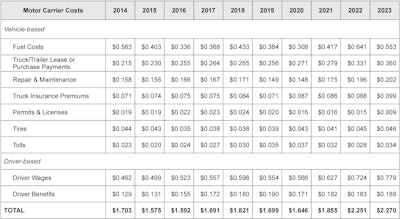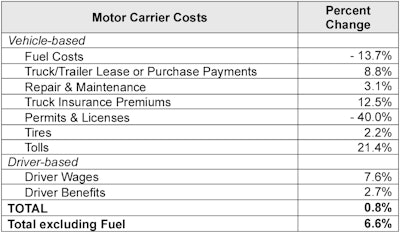Trucking expenses climbed to a new high in 2023 for the third year in a row, according to research released Tuesday by the American Transportation Research Institute (ATRI). Costs were dragged upward by a soft freight market that challenged efficiency.
After first cresting the $2 per mile mark in 2022, the overall marginal costs of operating a truck hit a new record $2.27 per mile in 2023 — a 0.8% increase from 2022. Cost per mile, including driver compensation cost, has climbed 62.4 cents since 2020.
Respondents to ATRI’s survey earlier this year ranged in size from fewer than 5 trucks to more than 1,000 trucks, and everything in between. Fleets with fewer than 5 trucks made up 19.8% of respondents, while fleets over 1,000 trucks made up 14.4% of respondents. The largest group of respondents had between 26 and 100 trucks (22.8%).
Overall, 2023 expenses rose moderately across most categories, ATRI found, with average costs across most line-items increasing at less than half the rates experienced during 2021 and 2022.
Average marginal costs per mile, 2014-2023
 ATRI
ATRI
Truck and trailer payments grew 8.8% to 36 cents per mile, driver wages 7.6% to 77.9 cents per mile, and repair and maintenance costs added 3.1% to 20.2 cents per mile.
Regarding driver wages, ATRI asked fleets about their use of contracted owner-operators, and how much those operators were paid. ATRI found that even with the soft spot market and lower freight volumes in 2023, leased owner-operator compensation increased to $2.10 per mile on average when combining hard pay and benefits.
[Related: Fighting ‘cheap freight’ one load at a time: Get a real read on revenue, costs]
The report noted that “some carriers pay OOs considerably less than the average … because they offer OOs reduced prices on carrier-owned maintenance shops or fuel depots.” On the flip side, “other carriers offer OO compensation structures that place more emphasis on bonuses, such as per-mile safety or performance pay.”
Trucking insurance premiums (auto liability and cargo) grew by 12.5% to 99 cents per mile after two years of negligible change, and that’s a trend that is likely to extend itself, ATRI noted.
2022-2023 annual change in average costs per mile
 ATRI
ATRI
In the first two months of 2024, respondents to ATRI’s survey noted a 6.8% increase in insurance premiums per mile on average compared with 2023, although the report suggests recent tort reforms and a falling number of truck-involved crashes could lead to some relief later this year or next.
[Related: Yes, you can reduce your trucking insurance premium … and I have the customers to prove it!]
The average truck age among survey respondents dropped from 4.7 years in 2022 to 3.8 years in 2023, a historically low average age following aggressive equipment buying in late 2022 and 2023. That followed record-high average ages during the equipment and parts shortages of 2020 and 2021.
While the 2023 increase was only 0.8% over the previous year, when fuel costs are excluded, marginal costs rose 6.6% to $1.716 per mile. Overall, fuel costs — down 13.7% in 2023 from 2022 to 55.3 cents per mile — helped keep operational costs more in line with 2022.
Fuel in 2023 was among trucking cost centers to see the biggest decrease from 2022, dropping 8.8 cents per mile. In the first two months of 2024, carriers reported a decrease of 3.1% in fuel costs per mile on average compared with 2023. According to ATRI, if present conditions hold, average fuel costs for 2024 could drop to 50 cents per mile, or down about a nickel per mile from 2023.
Rising costs collided with low freight rates, straining profitability across the industry. Average operating margins were 6% or lower in all fleet sizes and sectors other than LTL, ATRI found. The truckload and specialized sectors experienced drops in per-mile or per-truck revenue, and most saw “other costs” — expenses outside of the core marginal line-items — increase as a share of total revenue.
Marginal costs on a per-hour basis were $91.27, up 0.5% from $90.78 in 2022. This per-hour cost increased at a lower rate than the per-mile cost figure because the average truck speed in 2023 fell slightly from 2022, ATRI said. —Jason Cannon contributed to this report
[Related: Who is really hauling all the cheap freight? Owner-ops weigh in]